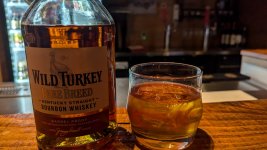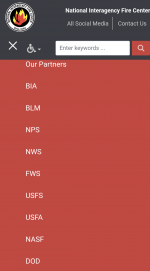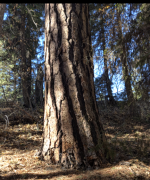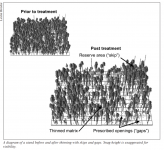I'm sitting at my bar after we just closed. I just opened my personal bottle of Rare Breed I scooped up today.

I spent almost an hour talking about fires with my buddy Phil tonight. Phil is a smokejumper for the US Forest Service. Before that he was a heli-attack for the Interagency Fire Management Center out of Boise. That is the national HQ for all wildfires. There are 9 mother17ing agencies involved in wildfires at the national level. Some fires require 7-8 to get involved. Problem #1 right there. Of course each agency has a different agenda so it's usually a **** show and that doesn't even include the state and local agencies.

Look up the acronyms on your own.
While talking to Phil tonight (and we never even mentioned LA) an old codger named Dan walked in with his wife. Dan's an old retired smokejumper. He brings a crew in once a month of 10 old retired jumpers and they pound beer like college kids. Anyhow, he sat down in chimed in as well.
They both agree that weather is by far the biggest factor. They also love prescribed burns, but it's hard to make a dent so they only focus on susceptible areas. For our area it's a very short window in October and possibly early November that it can happen. This year we went straight from extreme fire danger to heavy snow and they got a week's worth of burns in before there was to much snow on the ground.
Where Dan and Phil differed is how fires should be addressed.
Dan is old school. He says smokejumpers suppress fires. That's our job. If there's a flame we're there to put it out. Initial Attack is the saying and waiting around is never rewarded.
Phil is new school. He says natural fires need to burn. Only structures need be protected. Fires caused by mother nature on public land not threatening anything need to run their natural course. While not pleasant, it's necessary. If we keep putting fires out, the next one will be even bigger.
Obviously Dan and Phil were not in tonight. But they are real people and friends of mine. We have had these conversations in the past. I tend to agree with Phil and I will explain why. Like I mentioned in the other thread, the smokejumpers and tanker pilots are just a stones throw away from my restaurant and bar. They come in all the time and in the summer so get government contracts to feed the hotshot crews.
I myself was a forestry student myself once at Dear Old Mississippi State. I learned enough to know I didn't want to get bit by cottonmouths walking around the woods for not much more than minimum wage at the time and transfered to forest products. Where the real money is... making $3-4/hr over minimum wage.
Anyways. We learned about southern forestry practices. Lots of corporate and private softwood plantations and natural hardwood stands. There obviously wasn't a huge focus on the west, at least for my coursework.
But the similarities are here . From 1900 -1960 we cut almost every 17ing old growth tree in this country down. In the south everyone planted genetically modified fast growing loblolly pine to increase fiber yield per acre. In the west, it was just left to regenerate. Well, that's the rub.
The predominant species of tree in western fire country should be Redwoods and Ponderosa pines. When healthy and mature, it takes a hell of fire to do damage to either of these. When young they burn. When old and sick they burn.
Here's a healthy ponderosa in my backyard. That bark is 6" thick and it's a long way up to something that will burn.

So throughout the millinia before man got involved, these forests would often have fires that killed off old sick trees and young trees, but leave mature trees standing that would produce more you trees and so forth. Every once and a while a 17ing rebel lodgepole pine would take up residence in the neighborhood, but the next fire got that sucker.
Sure some fires wiped everything out, but often enough it was more selective. Well as soon as we start clear cutting old growth healthy forest in 1900 when the railroads arrived, we 17ed up the natural cycle. Now those clear-cut lands are where trash trees grow. They don't have small fires with lodgepoles, they burn like diapers filled with kerosene.
Unlike the south, it's virtually impossible to replant western timberland with seedlings in mass scale. The terrain is to difficult and so much of the land is public land and cut on contract. So when have ended up with 65-120 years worth of trash out west and 2nd or 3rd generations of lab modified ultra fast growth plantation pine in the south. The trash out west burns like a mofo and the trash in the south is half as strong and twice as crooked.
We 17ed with mother nature and are now dealing with it. I want less government, not more. We could triple the forest/fire services budget and we'd still not be able to stop wildfires. And it would have to triple again in a few years as it keeps getting exponentially worse.
I have a saying... I often use it when talking about transgender bullshìt.
If creationism and evolution both agree that you're wrong, you probably are... In forestry/land management we have screwed up God's will and/or the natural evolution of things... Either way there's a price to pay.
As for LA. Don't really care, but I hope it draws some attention to the overall subject. I figured the rioters would have burned it down a long time ago in a Sodom and Gomorrah situation. But from the wildfires I have seen, trying to use a city water system with 6-12" pipes supplying hydrants is not going to do much. It takes mother nature's help and weeks worth of work to make the fire double back on itself and run out of fuel to control wildfire.
TLDR. We 17ed around with mother nature in the south and ruined the quality of our lumber and diversity of our forests. We 17ed around with mother nature in the west and ruined the quality of our forests and diversity of our lumber.

I spent almost an hour talking about fires with my buddy Phil tonight. Phil is a smokejumper for the US Forest Service. Before that he was a heli-attack for the Interagency Fire Management Center out of Boise. That is the national HQ for all wildfires. There are 9 mother17ing agencies involved in wildfires at the national level. Some fires require 7-8 to get involved. Problem #1 right there. Of course each agency has a different agenda so it's usually a **** show and that doesn't even include the state and local agencies.

Look up the acronyms on your own.
While talking to Phil tonight (and we never even mentioned LA) an old codger named Dan walked in with his wife. Dan's an old retired smokejumper. He brings a crew in once a month of 10 old retired jumpers and they pound beer like college kids. Anyhow, he sat down in chimed in as well.
They both agree that weather is by far the biggest factor. They also love prescribed burns, but it's hard to make a dent so they only focus on susceptible areas. For our area it's a very short window in October and possibly early November that it can happen. This year we went straight from extreme fire danger to heavy snow and they got a week's worth of burns in before there was to much snow on the ground.
Where Dan and Phil differed is how fires should be addressed.
Dan is old school. He says smokejumpers suppress fires. That's our job. If there's a flame we're there to put it out. Initial Attack is the saying and waiting around is never rewarded.
Phil is new school. He says natural fires need to burn. Only structures need be protected. Fires caused by mother nature on public land not threatening anything need to run their natural course. While not pleasant, it's necessary. If we keep putting fires out, the next one will be even bigger.
Obviously Dan and Phil were not in tonight. But they are real people and friends of mine. We have had these conversations in the past. I tend to agree with Phil and I will explain why. Like I mentioned in the other thread, the smokejumpers and tanker pilots are just a stones throw away from my restaurant and bar. They come in all the time and in the summer so get government contracts to feed the hotshot crews.
I myself was a forestry student myself once at Dear Old Mississippi State. I learned enough to know I didn't want to get bit by cottonmouths walking around the woods for not much more than minimum wage at the time and transfered to forest products. Where the real money is... making $3-4/hr over minimum wage.
Anyways. We learned about southern forestry practices. Lots of corporate and private softwood plantations and natural hardwood stands. There obviously wasn't a huge focus on the west, at least for my coursework.
But the similarities are here . From 1900 -1960 we cut almost every 17ing old growth tree in this country down. In the south everyone planted genetically modified fast growing loblolly pine to increase fiber yield per acre. In the west, it was just left to regenerate. Well, that's the rub.
The predominant species of tree in western fire country should be Redwoods and Ponderosa pines. When healthy and mature, it takes a hell of fire to do damage to either of these. When young they burn. When old and sick they burn.
Here's a healthy ponderosa in my backyard. That bark is 6" thick and it's a long way up to something that will burn.

So throughout the millinia before man got involved, these forests would often have fires that killed off old sick trees and young trees, but leave mature trees standing that would produce more you trees and so forth. Every once and a while a 17ing rebel lodgepole pine would take up residence in the neighborhood, but the next fire got that sucker.
Sure some fires wiped everything out, but often enough it was more selective. Well as soon as we start clear cutting old growth healthy forest in 1900 when the railroads arrived, we 17ed up the natural cycle. Now those clear-cut lands are where trash trees grow. They don't have small fires with lodgepoles, they burn like diapers filled with kerosene.
Unlike the south, it's virtually impossible to replant western timberland with seedlings in mass scale. The terrain is to difficult and so much of the land is public land and cut on contract. So when have ended up with 65-120 years worth of trash out west and 2nd or 3rd generations of lab modified ultra fast growth plantation pine in the south. The trash out west burns like a mofo and the trash in the south is half as strong and twice as crooked.
We 17ed with mother nature and are now dealing with it. I want less government, not more. We could triple the forest/fire services budget and we'd still not be able to stop wildfires. And it would have to triple again in a few years as it keeps getting exponentially worse.
I have a saying... I often use it when talking about transgender bullshìt.
If creationism and evolution both agree that you're wrong, you probably are... In forestry/land management we have screwed up God's will and/or the natural evolution of things... Either way there's a price to pay.
As for LA. Don't really care, but I hope it draws some attention to the overall subject. I figured the rioters would have burned it down a long time ago in a Sodom and Gomorrah situation. But from the wildfires I have seen, trying to use a city water system with 6-12" pipes supplying hydrants is not going to do much. It takes mother nature's help and weeks worth of work to make the fire double back on itself and run out of fuel to control wildfire.
TLDR. We 17ed around with mother nature in the south and ruined the quality of our lumber and diversity of our forests. We 17ed around with mother nature in the west and ruined the quality of our forests and diversity of our lumber.
Last edited:

